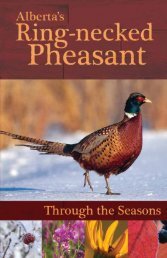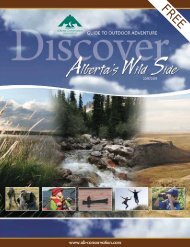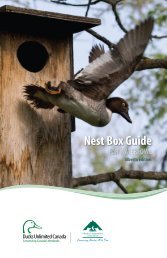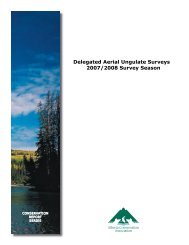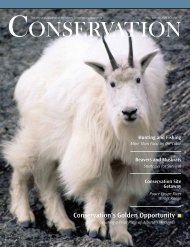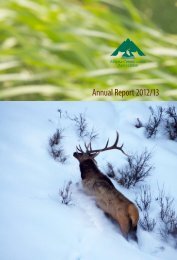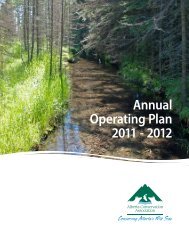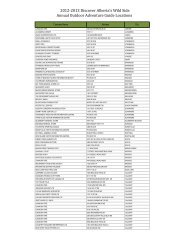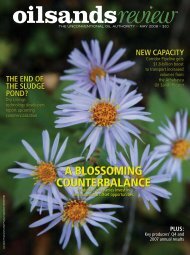Download Magazine PDF - Alberta Conservation Association
Download Magazine PDF - Alberta Conservation Association
Download Magazine PDF - Alberta Conservation Association
You also want an ePaper? Increase the reach of your titles
YUMPU automatically turns print PDFs into web optimized ePapers that Google loves.
Hiding in the openUnlike the cottontail, hares and jackrabbitsspend most of their lives exposed in the wild,which influences aspects of their biology.These speedsters rarely seek refuge, exceptin winter, when extreme cold and windforce them to dig shallow tunnels in thesnow. The summer brown fur of both thesnowshoe hare and the jackrabbit turns whitein October to better camouflage themselvesagainst predators. The change is caused bythe shrinking hours of daylight, graduallyproducing a bleached bunny.Mad as a March hare?This describes the springtime antics of rabbitsand hares when their sexual hormones areraging. In the early stages of the breedingseason, several males may chase a singlefemale. Rival males thump their back feet andchatter their teeth at each other in aggression.They often chase and body slam one another,biting and scratching with their front and rearpaws. In serious fights, one of the bucks maylock his teeth in the fur on the back of hisopponent’s neck and claw with its hind paws.In some years, up to 20 percent of the malesin a snowshoe hare population carry battlescars on their ears, face or hindquarters fromthe breeding season.Urine for loveThe lucky suitor matches up with a femalein a rather unconventional courtship. Asone of the pair leaps in the air, the otherruns beneath and is sprayed with urine byits airborne partner. Urine is a cocktail ofchemicals that mates can use to evaluatethe worthiness of a prospective partner.It can advertise good health or betray anillness. Biologists call rabbits and hares“induced ovulators,” meaning the femaledoes not produce eggs until she is adequatelystimulated by the male. Apparently all thechasing, leaping and urinating are necessarysteps to coax the female into reproductivemode.Just think, you can now tell exactly whenbreeding season begins in <strong>Alberta</strong>: urine willbrightly paint the snow. The telltale yellowstains can cover an area nine metres indiameter.Small scale survivalIn <strong>Alberta</strong>, hares and cottontails are usuallyborn in May, after a month or two of bunnymadness. Newborn mountain cottontails,called kittens or bunnies, are born naked,blind, and utterly helpless. They spend thefirst several weeks of their life shelteredinside a burrow where they are swaddled indried grasses and soft fur plucked from theirmother’s belly.Baby hares, called leverets, are born in ashallow depression on the surface of theground. They begin life with a full coat of fur,their eyes open within an hour of birth, andthey can move shortly afterward, althoughthey are powerless against predators. In fact,80-90% of young lagomorphs are killed in thefirst few months of their lives. nBEHINDTHE SCENESLakeAerationA little about lagomorphs:Lagomorphs differ from rodents such as beavers,squirrels and mice in having a second pair of upperfront teeth, called “peg teeth,” hidden behind the largeouter ones.Male lagomorphs are called bucks, and females does.Young hares and jackrabbits are nursed just once perday, shortly after sunset for 5-10 minutes. This minimalmaternal contact lessens detection by predators.Lagomorphs produce two kinds of droppings: duringthe day, soft mucous-coated ones that are reingested,and at night, 200-400 hard pellets that are discarded.Reingesting increases the nutrition they can extractfrom their diet.Cautionary tailSpring and summer are the most commontimes to see wild babies. If you come acrossbaby rabbits or other young animals,please leave them alone! The mother islikely close by. Your actions may exposethem to predators or prevent their parentsfrom returning to care for them.<strong>Alberta</strong> Fish and WildlifeDr. Lynch is a popular guest lecturer and an awardwinningscience writer. His books and photographycover a wide range of subjects, including the biologyof owls, penguins and northern bears; arctic, borealand grassland ecology; and the lives of prairie birdsand mountain wildlife.22CONSERVATION MAGAZINE SPRING/SUMMER 2012





